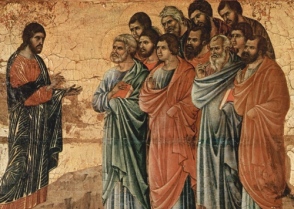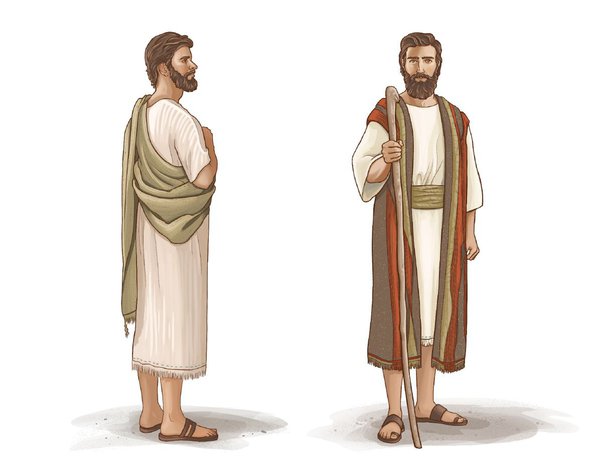What Did Jesus Wear: Unveiling Biblical Attire
Jesus wore a tunic, a simple garment that typically reached slightly below the knees. In biblical times, people dressed in long flowing robes to stay cool, with the material and texture reflecting their wealth.
Clothing in Jesus’ time was influenced by the climate, with peasants wearing a loincloth and/or tunic and cloak. The color of Jesus’ robe is also a topic of interest, with some suggesting a purple robe. However, the most common attire for Jesus was a tunic, reflecting the simplicity and modesty that he embraced.
This choice of clothing also carries spiritual significance, as it emphasizes the importance of inner faith over outward appearances, echoing the biblical teachings to not judge by mere appearances.

Credit: www.quora.com
Historical Context Of Biblical Attire
Exploring the clothing of Jesus in biblical times offers a glimpse into the cultural and societal norms of that era. Understanding the historical context of biblical attire sheds light on the significance of clothing in Jesus’ time.
Cultural Influences On Clothing
- Climate dictated clothing choices.
- Long flowing robes were common.
- Material and texture varied based on wealth.
Class And Clothing In Jesus’ Time
- Peasants wore loincloths and tunics.
- Wealthy individuals adorned themselves in finer fabrics.
- Jesus likely wore a tunic that ended below the knees.
Jesus’ Garments: A Closer Look
The attire of Jesus Christ has been a topic of interest and curiosity for centuries. While it is widely accepted that he wore a tunic, there are many questions surrounding the other garments he may have worn. In this article, we will take a closer look at Jesus’ garments, including his tunic and outer garments.
Tunic: The Chitōn
Jesus’ tunic, also known as the chitōn, was a common garment worn by men during his time. It was typically made of linen or cotton and was worn next to the skin. The tunic was a simple, loose-fitting garment that was often belted at the waist. It was typically knee-length and had short sleeves.
Among men, only the very wealthy wore long tunics that reached their ankles. Jesus, being a humble carpenter, likely wore a shorter tunic that fell just below the knees. The color of his tunic is unknown, but it was likely a neutral color such as white or beige.
Outer Garments And Cloaks
In addition to his tunic, Jesus may have worn other garments such as a cloak or outer robe. These were typically made of wool and were worn over the tunic for warmth. It is also possible that Jesus wore a prayer shawl or mantle, which was a symbol of piety and devotion.
The color of Jesus’ outer garments is not known, but it is believed that he may have worn a seamless robe, which was a luxury item during his time. This robe was woven in one piece, which made it more expensive than other robes that were sewn together from multiple pieces of fabric.
While there is much that is unknown about the garments of Jesus Christ, we can be certain that he dressed simply and humbly. His attire reflected his humility and his focus on spiritual matters rather than material possessions. By taking a closer look at his garments, we can gain a deeper understanding of the man who wore them and the values he embodied.
Significance Of Colors
In biblical times, colors held significant symbolism and were often associated with various meanings. The attire worn by Jesus, including the colors of his garments, carries spiritual and symbolic significance that provides insight into his identity and purpose.
Symbolism Of The Purple Robe
The purple robe worn by Jesus holds profound symbolism. In ancient times, the color purple was rare and expensive, often associated with royalty and wealth. The purple robe worn by Jesus symbolizes his divine kingship and sovereignty, signifying his authority and the majesty of his divine nature.
Meaning Behind The Scarlet Robe
The scarlet robe worn by Jesus carries symbolic significance as well. Scarlet, a deep red color, was often associated with wealth, power, and importance. The scarlet robe symbolizes Jesus’ sacrifice and his role as the atoning savior, signifying his willingness to shed his blood for the redemption of humanity.

Credit: www.midsouthpresbytery.org
Dressing For The Climate
When it comes to understanding what Jesus wore, it’s essential to consider the climate and the practical aspects of clothing in ancient times. The attire of that era was influenced by the environmental conditions, and people dressed to adapt to the climate they lived in.
Adaptations For Heat
In the warm climate of the Middle East, people had to dress in a way that offered protection from the scorching sun while keeping them cool. The clothing needed to provide shade and ventilation to combat the heat.
Materials Used In Ancient Attire
Ancient attire was often made from materials that were suitable for the climate. The use of lightweight and breathable fabrics such as linen and cotton was common, allowing for air circulation to keep the body cool. These materials were not only practical but also reflected the available resources and technological capabilities of that time.
Accessories And Footwear
When it comes to accessories and footwear, the attire of Jesus included specific elements that were common during his time. Let’s explore the head coverings, belts, and sandals that were part of Jesus’ wardrobe.
Head Coverings And Belts
During Jesus’ time, head coverings and belts were essential parts of everyday attire. The head coverings, often referred to as turbans or shawls, were worn for protection from the sun and to maintain modesty. Additionally, belts were used to cinch the loose-fitting tunics, providing a more secure and practical fit.
Sandals: The Common Footwear
As for footwear, sandals were the prevailing choice during Jesus’ era. These open-toed and often simple leather sandals were the standard choice for traversing the terrain of the region and were worn by people from all walks of life.

Credit: friarmusings.com
Ceremonial And Ritual Clothing
Ceremonial and ritual clothing held significant importance in the attire of Jesus, reflecting spiritual symbolism and religious traditions. These garments were not merely for practical purposes, but also held deep spiritual and symbolic significance.
The Prayer Mantle And Tassels
One of the distinctive elements of Jesus’ ceremonial attire was the prayer mantle, also known as a shawl or cloak, adorned with tassels. This prayer mantle held deep spiritual significance, symbolizing the commitment to prayer and devotion to God. The tassels, known as tzitzit, were a reminder of the commandments and served as a visual representation of the spiritual duties and obligations.
Garments For Spiritual Significance
Garments worn by Jesus held profound spiritual significance, far beyond their outward appearance. Each piece of clothing carried symbolic meaning, reflecting the religious and spiritual principles of the time.
Socio-economic Implications
Jesus’ attire during his time reflected the socio-economic status of individuals. Clothing was not only a means of covering the body but also a reflection of one’s wealth and social status. The clothing of the wealthy was vastly different from that of the poor. In this post, we will explore the socio-economic implications of Jesus’ attire.
Clothing Of The Wealthy Vs The Poor
The clothing of the wealthy during Jesus’ time was made of high-quality materials such as silk, linen, and wool. They wore long robes that were decorated with various ornaments and colors. In contrast, the poor wore simple, plain clothing made of cheap materials like wool and animal skins. They wore a loincloth and/or tunic and cloak. The difference in clothing between the wealthy and the poor was stark, and it was evident in their daily lives.
Jesus’ Attire As A Reflection Of Status
Jesus’ attire was a reflection of his status as a humble preacher. He wore a simple tunic (chiton) that finished just below the knees, not at the ankles, which was typical for men during that time. This attire was not only practical but also symbolic of his humility and lack of material wealth. It also reflected his message of simplicity and the importance of inner character over outward appearance.
Moreover, Jesus’ attire also reflected his association with the poor and marginalized. He identified with the poor and did not want to be seen as someone who was above them. His attire was a means of relating to them and showing that he was one of them.
In conclusion, Jesus’ attire during his time had significant socio-economic implications. It not only reflected one’s wealth and social status but also conveyed messages of humility and association with the poor. As we reflect on Jesus’ attire, we are reminded of the importance of inner character and simplicity over outward appearance.
Modern Depictions Vs Historical Accuracy
The modern depictions of Jesus often show him in flowing robes, but historical accuracy suggests that he likely wore a tunic, a common garment for men in biblical times. The choice of clothing was influenced by the climate and social status, with wealthier individuals able to afford more luxurious materials.
Artistic Interpretations Of Jesus’ Look
Artistic depictions often show Jesus in long robes with baggy sleeves, as seen in various artworks over the centuries.
Misconceptions About Biblical Clothing
Contrary to popular belief, Jesus likely wore a tunic (chitōn) that ended slightly below the knees, not at the ankles.
Theological Perspectives On Attire
In the New Testament, Jesus is often depicted wearing a simple tunic, a common attire for men during that time. The emphasis is not on his clothing, but on his teachings and actions, showing that God is more concerned with the condition of our hearts than our outward appearance.
Inward Faith Vs Outward Appearance
God values our hearts more than our clothing choices.
Lessons From Jesus’ Simplicity
Jesus exemplified humility and simplicity in his attire.
Preservation And Study Of Ancient Textiles
Ancient textiles provide valuable insights into the clothing worn during biblical times. The preservation and study of these textiles offer a glimpse into the fashion trends, materials, and craftsmanship of the past.
Archaeological Findings
Archaeological excavations have unearthed ancient textiles, including fragments of garments and burial shrouds, shedding light on the clothing styles of different periods. These findings help researchers understand the fabric types, colors, and weaving techniques used in ancient clothing.
Research On First-century Clothing
Researchers analyze and interpret ancient textiles to reconstruct the clothing worn in the first century. By studying the fibers, dyes, and designs of these textiles, scholars can piece together the attire worn by individuals like Jesus and his contemporaries.
Frequently Asked Questions
How Did People Dress In Jesus Time?
People in Jesus’ time wore long flowing robes based on their wealth and climate conditions. Peasants typically wore a loincloth, tunic, and cloak.
What Did Jesus Wear Around His Waist?
Jesus wore a tunic around his waist. This garment was a simple, knee-length undergarment commonly worn by men in ancient times.
What Color Robe Did Jesus Wear?
Jesus likely wore a simple tunic, a basic garment that covered the upper body and ended just below the knees.
Does Jesus Care About What We Wear?
While there is no specific dress code mentioned in the Bible, it is important to dress modestly and respectfully when attending church. Ultimately, what matters to Jesus is the condition of our hearts, not our outward appearance. Therefore, we should focus on cultivating a heart that honors and glorifies God, rather than being consumed by what we wear.
Conclusion
Discovering what Jesus wore reveals his humility and simplicity. His attire reflected a modest tunic, emphasizing inner qualities over outward appearance. Understanding Jesus’ clothing choices offers insights into his character and teachings, emphasizing the importance of inner righteousness. Jesus’ modest garments symbolize spiritual values that transcend material possessions.

